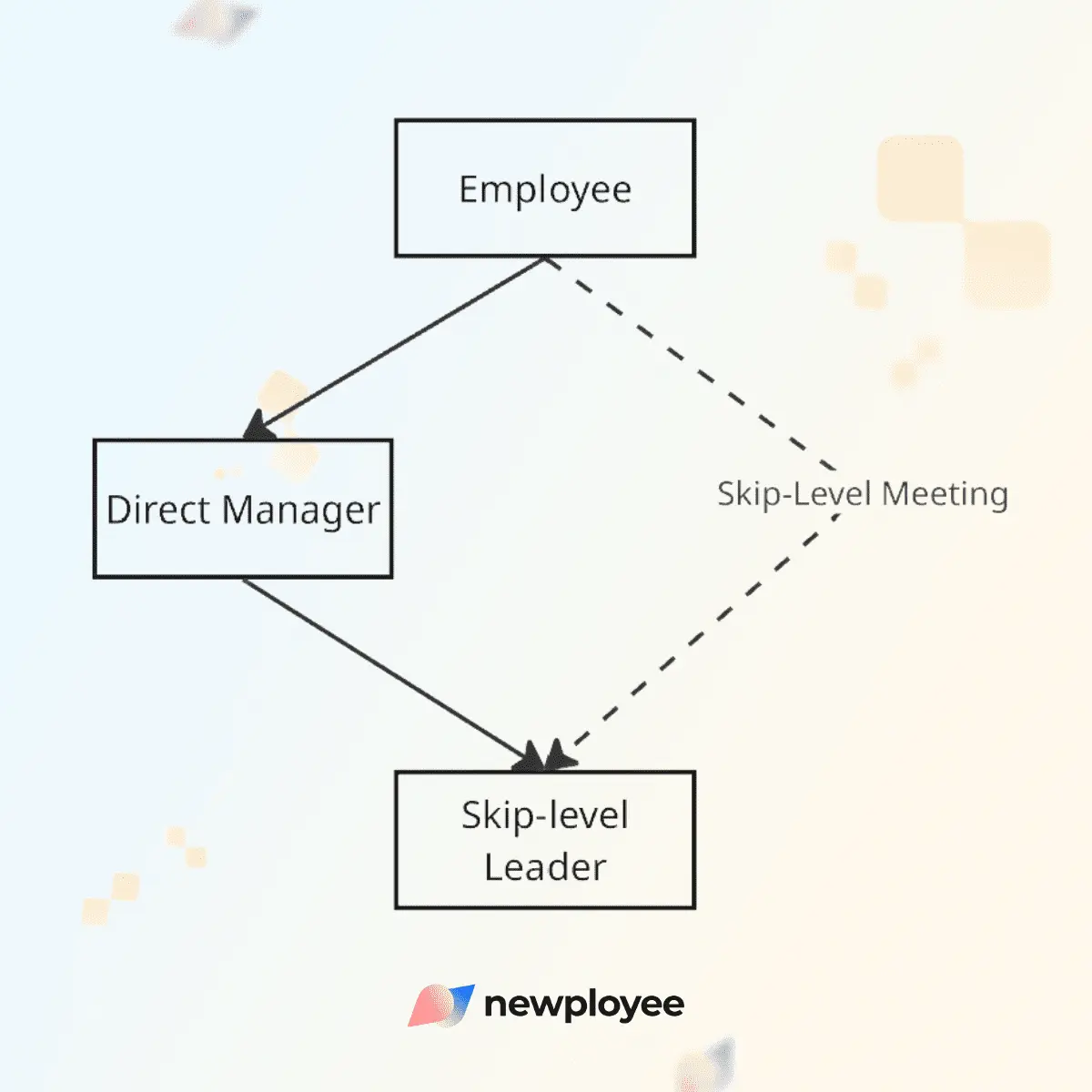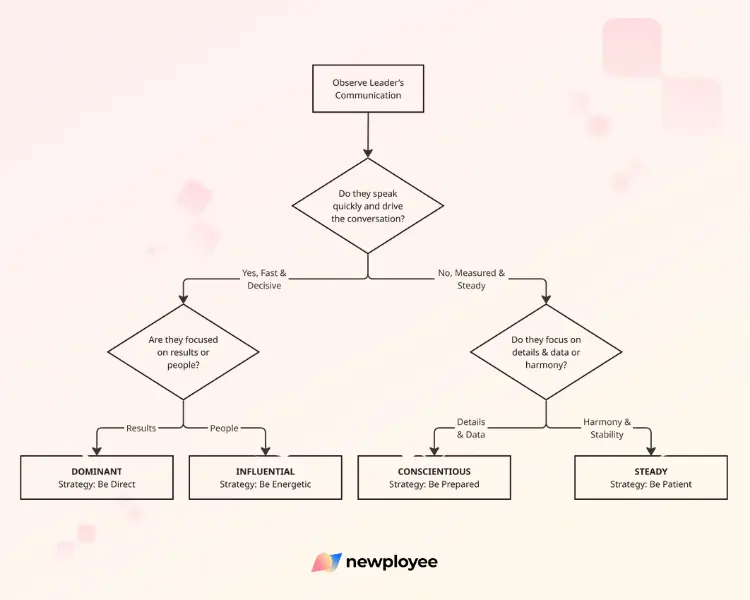A skip-level meeting isn't just another calendar invite, it's a strategic career accelerator.
This ultimate guide provides the blueprint to transform this opportunity from a nerve-wracking event into a pivotal moment for visibility, influence, and growth.
What Exactly is a Skip-Level Meeting?
A skip-level meeting is a direct conversation between an employee and their manager's manager (or higher), bypassing the immediate chain of command.

Core Purpose: To foster transparency, provide unfiltered ground-level insights to leadership, and offer employees a platform for visibility.
The Mindset Shift: Reframe Your Approach
Preparation For A Skip-Level Meeting: A Step-by-Step Playbook
1. Deep Dive: Research Your Skip-Level Leader
Go beyond a simple LinkedIn stalk. Build a comprehensive profile.
Your Research Toolkit:
- Background: What was their career path? (Engineering, Sales, Finance?)
- Recent Focus: Key themes in their last 3 all-hands or memos?
- Strategic Priorities: Top 2-3 goals for their org this quarter?
- Communication Style: Data-driven, visionary, story-teller?
- Pet Projects: Initiatives they personally champion?
Actionable Tactics:
- Use Internal Tools: Search your company wiki for their past presentations.
- The Colleague Intelligence: Ask a trusted senior peer: "What resonates with [Leader's Name] in a conversation?"
2. Strategic Intent: Clarify the Meeting's Purpose
A vague meeting is a missed opportunity. Seek clarity.
3. Narrative Crafting: Build Your Talking Points
Facts tell, but stories sell. Use the STAR method but elevate it to STAR-R.
- Situation: The context. (1 sentence)
- Task: The goal. (1 sentence)
- Action: What you did + the leadership behavior you demonstrated. (This is the key!)
- Result: The quantifiable impact.
- Reflection: What you learned and how it applies going forward. (This is the elevator!)
Use Case: The Project Post-Mortem
- S: "In H2, our user onboarding funnel had a 40% drop-off."
- T: "My mission was to identify the leak and fix it."
- A: "I led a cross-functional deep-dive with data science, demonstrating ownership. We discovered the sign-up was too complex. I influenced without authority to prioritize a streamlined redesign."
- R: "We cut the drop-off rate by half, adding 15,000 active users per month."
- R: "I learned the power of data in aligning cross-functional teams, a lesson I'm now applying to our current project on customer retention."
4. Master the Dialogue: Anticipate & Answer
Prepare for the curveballs. These questions are tests of your judgment and emotional intelligence.
5. The Art of the Question: Engage as a Peer
Your questions reveal your level. Ask like a leader.
The Question Bank:
- On Strategy: "If you had to bet on one emerging trend that will disrupt our business in 3 years, what would it be and why?"
- On Execution: "When you look across the organization, where do you see the biggest gap between our strategy and its execution?"
- On Personal Growth: "Looking back at your career, what was a key skill you had to develop when you moved into a role at this level?"
The Leadership Style Decoder: A Practical Guide
Use this flowchart during your meeting to quickly "read" the leader and adapt your communication in real time. Start by asking yourself the first question:

Style 1: The Dominant - "Bottom-Line Focus"
- How to Adapt: Be direct and concise. Start with the result. Use words like "impact," "efficiency," "results."
- Avoid: Rambling, excessive detail, emotional appeals.
Style 2: The Influential - "Big Picture & Energy"
- How to Adapt: Be enthusiastic. Start with the vision. Use words like "vision," "exciting," "innovation," "collaborate."
- Avoid: Dry data without a story, low energy.
Style 3: The Steady - "Trust & Stability"
- How to Adapt: Be patient and build rapport. Emphasize team and process. Use words like "team," "trust," "collaboration," "sustainable."
- Avoid: Being pushy, implying drastic change.
Style 4: The Conscientious—"Accuracy & Data"
- How to Adapt: Be prepared and precise. Start with data and logic. Use words like "data," "evidence," "process," "accuracy."
- Avoid: Vague statements, unsubstantiated claims.
Case Study: From Idea to Impact
The Player: Sarah, a Mid-Level Product Manager at a FinTech.
The Opportunity: Skip-level with the VP of Product.
The Preparation:
- Research: Discovered the VP was obsessed with "customer obsession" metrics and reducing "time to value."
- STAR-R Narrative: Prepared a story about how she simplified a key feature, cutting setup time from 3 days to 2 hours, directly tying it to the VP's priority.
- Strategic Question: "How can we better institutionalize the 'voice of the customer' in our early-stage planning to further reduce time to value across the entire product suite?"
The Outcome: The VP was impressed by the direct alignment. Sarah's idea was championed, and she was asked to lead a tiger team to implement it, significantly increasing her visibility and impact.
In-The-Room Execution: Your Moment to Shine
The First 5 Minutes:
- Warm Gratitude: "Thank you for your time. I know how valuable it is."
- Context Setting: "I thought we could discuss [Topic A], [Topic B], and I'm also keen to get your perspective on [Your Strategic Question]."
- Brief Recap (if needed): "As context, I've been leading [Your Key Project] for the last 6 months."
Body Language & Presence:
- Virtual: Camera ON. Eye contact with the lens. Clean, professional background.
- In-Person: Confident posture. Lean in slightly to show engagement. Put your phone away.
The Final 5 Minutes:
- Signal the End: "I want to be respectful of your time."
- Summarize: "My key takeaway is [X]. I'm excited to act on [Y]."
- Parting Gratitude: "This was incredibly valuable. Thank you."
The Follow-Through: Where Relationships Are Built
The meeting is just the first step. The follow-up cements the impression.
The 24-Hour Thank You Email:
The Crucial Debrief with Your Manager:
This is non-negotiable for maintaining trust.
Red Flags & How to Navigate Them
Your Success Checklist: A Summary
Final Word: A skip-level meeting is a gift. It’s a direct line to the decision-makers who shape your company's future, and yours. Walk in not as a subordinate, but as an informed, strategic partner ready to contribute at a higher level. You've got this.
.webp)





-min.webp)

